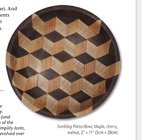I'm in the glue-up phase of making a tumbling bowl similar to the one by Peter M. Smith that I found at woodturner.org. Eventually I'll get to the point of mounting a rounded block of "cells" on my lathe and get to turning it into a bowl shape. However, I'm not sure about the "best" tool to use to shape the thing. When each cell is assembled, it has three side grain sides and three end grain sides. So, unlike the segmented bowls I've turned, I won't have 100 percent side grain to work with while shaping it. What would you folks suggest I use on this piece? I've got a couple different carbide turning tools and two round nose scrapers. Also have a bowl gouge, but since acquiring the carbide tools a few years ago my use of the bowl gouge has gone to zero, while my "fear" of destroying something with it has gone the other direction. So my preference would be to use the bowl gouge as a last resort. Neither of my scrapers are negative rake grind.
Suggestions?
Suggestions?

